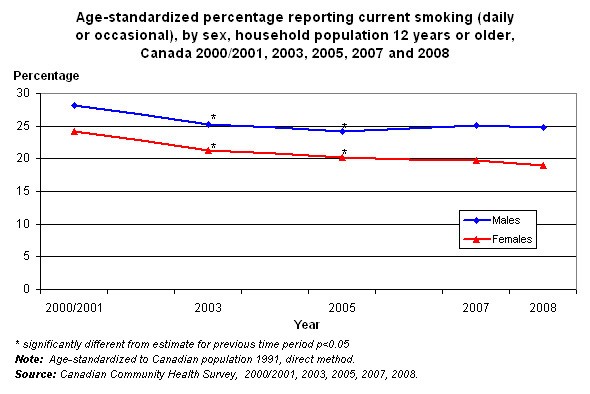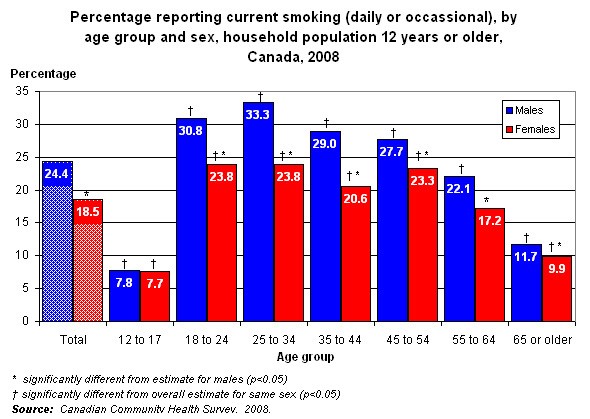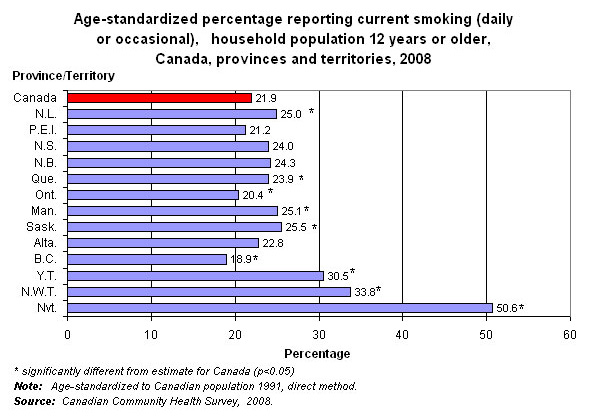Current smoking
Archived Content
Information identified as archived is provided for reference, research or recordkeeping purposes. It is not subject to the Government of Canada Web Standards and has not been altered or updated since it was archived. Please "contact us" to request a format other than those available.
Smoking prevalence was measured as the percentage of the population aged 12 or older who reported current smoking (daily or occasional). This definition does not take the number of cigarettes smoked into account.
Importance of indicator
Smoking is a risk factor for lung cancer and many other diseases1. Monitoring trends in smoking prevalence is important for understanding smoking behaviours over time and for informing policy, service delivery and prevention programs.
Background
As strong evidence about the link between smoking and lung cancer and other diseases accumulated and social acceptability declined, the prevalence of smoking in Canada has dropped in recent decades2.
Smoking prevalence declined among males and females in all age groups3.
Smoking prevalence declined among youth, as they became less likely to start smoking in the first place3. This suggests that the overall prevalence of smoking will continue to drop because people older than age 18 rarely start smoking3,4.
Smokers who quit also contributed to the declining prevalence.
Highlights and graphs
Time trend

- Among Canadians aged 12 or older, the age-standardized percentage of current smoking (daily or occasional) declined from 2000/2001 to 2005.
- Since then, smoking prevalence stabilized for males and continued to drop slightly for females (the change between 2005 and 2008 was not statistically significant for males, but was for females).
- Males were consistently more likely to be current (daily or occasional) smokers than women.
Note: Age–standardized, direct method to 1991 Canada population.
Age group and sex

- In 2008, 24.4% of males and 18.5% of females aged 12 or older were daily or occasional smokers: an estimated 3.4 million males and 2.6 million females.
- In all but the youngest age group, males were more likely than females to be smokers. At ages 12 to 17, approximately 8% of males and females reported that they were smokers.
- Smoking prevalence among both males and females aged 12 to 17 was lower than the respective prevalence for Canada overall.
- Males and females aged 18 to 54 reported higher prevalence of smoking than the overall prevalence for the same sex.
- Males aged 55 or older were less likely than Canadian males overall to smoke, while among females, those 65 and older were less likely to smoke than were Canadian females overall.
Province

- In 2008, British Columbia and Ontario were the only provinces or territories in which the age-standardized percentage of daily or occasional smoking was below the percentage for Canada as a whole.
- In contrast, residents of Nunavut were more than twice as likely as Canadians overall to smoke.
- Age-standardized percentages of smokers in Yukon and Northwest Territories were also higher than for Canadians overall.
- Residents of Newfoundland and Labrador, Quebec, Manitoba, and Saskatchewan were also more likely than Canadians overall to be smokers.
Note: Age–standardized, direct method to 1991 Canada population.
References
1.
Health Canada. Overview of health risks of smoking.
2. Ross N, Perez C. Attitudes toward smoking. Health Reports (Statistics Canada, Catalogue 82-003) 1998;10(3):23-33.
3. Shields M. Your Community, Your Health: Findings from the Canadian Community Health Survey (CCHS), smoking and diabetes Care: Results from the CCHS cycle 3.1 (2005). (Statistics Canada, Catalogue 82-621— No. 002, 2005.
4. Chen J, Millar WJ. Age of smoking initiation: Implications for quitting. Health Reports (Statistics Canada, Catalogue 82-003) 1998;9(4):39-46.
Other studies
Chen J. Age at diagnosis of smoking-related disease. Health Reports (Statistics Canada, Catalogue 82-003) 2003; 14(2): 9-19.
Deering KN, Lix L, Bruce S, Young TK. Chronic disease and risk factors in Canada's northern populations: longitudinal and geographic comparisons. Canadian Journal of Public Health. January/February 2009; 100(1): 14-7.
Galambos NL, Tilton-Weaver LC. Multiple-risk behaviour in adolescents and young adults. Health Reports (Statistics Canada, Catalogue 82-003) 1998; 10(2): 9-20.
Gaudette LA, Richardson A, Huang S. Which workers smoke? Health Reports (Statistics Canada, Catalogue 82-003) 1998; 10(3): 35-45.
Millar WJ. Reaching Smokers with Lower Educational Attainment. Health Reports (Statistics Canada, Catalogue 82-003) 1996; 8(2): 11-9.
Millar WJ, Hill G. Pregnancy and smoking. Health Reports (Statistics Canada, Catalogue 82-003) 2004;15(4): 53-6.
Pérez CE. Personal health practices: Smoking, drinking, physical activity and weight. Reports (Statistics Canada, Catalogue 82-003) 1999; 11(3): 83-90.
Shields M. Smoking—prevalence, bans and exposure to second-hand smoke. Health Reports (Statistics Canada, Catalogue 82-003) 2007; 18(3): 67-85.
Shields M. Smoking bans: Influence on smoking prevalence. Health Reports (Statistics Canada, Catalogue 82-003) 2007; 18(3): 9-24.
Shields M. The journey to quitting smoking. Health Reports (Statistics Canada, Catalogue 82-003) 2005; 16(3): 19-36.
Shields M. Youth smoking. Health Reports (Statistics Canada, Catalogue 82-003) 2005; 16(3): 53-7.
Stephens M, Siroonian J. Smoking prevalence, quit attempts and successes. Health Reports (Statistics Canada, Catalogue 82-003) 1998; 9(4): 31-7.
- Date modified:
